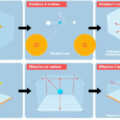In today’s data-driven world, the effective representation and manipulation of complex geometries is vital for a variety of applications including engineering simulations, computer graphics, and scientific computation. Mesh algorithms are powerful tools that allow for the conversion of complex shapes into manageable data structures called meshes, which facilitate analysis and visualization. This article delves into various mesh algorithms, their methodologies, and their application in different fields.
What is a Mesh?
At its core, a mesh is a collection of vertices, edges, and faces that represents the shape of a polyhedral object. In computational terms, a mesh subdivides a geometric space into discrete elements, enabling various analyses, such as finite element analysis (FEA) and computational fluid dynamics (CFD). These analyses are indispensable in fields ranging from architectural design to aerospace engineering.
A mesh can be structured (regular patterns) or unstructured (irregular patterns), depending on the specific needs of the representation and problem-solving applications. Structured meshes are commonly used in simpler domains, while unstructured meshes are preferred for more complex and arbitrary geometries.
Types of Mesh Algorithms
Mesh generation algorithms can be classified based on the dimensionality they target—1D (edges), 2D (faces), or 3D (volumes). Several algorithms cater to these dimensions with varied approaches and techniques, each suited for different types of geometrical challenges.

1. Delaunay Triangulation
One of the most popular techniques in mesh generation is the Delaunay triangulation method. This algorithm provides a method for creating a mesh of triangles by maximizing the minimum angle of the triangles formed. This approach effectively prevents long, skinny triangles that might compromise the quality of the mesh during subsequent numerical calculations.
2. Advancing Front Method
The Advancing Front Method starts from the boundary of the shape and incrementally adds elements, gradually filling in the interior until the entire domain is meshed. This method is particularly useful for complex geometries where boundary conditions play a significant role in the mesh structure.
3. Grid-Based Methods
Grid-based approaches use a structured mesh represented by a regular grid. In 2D, this typically results in quadrilateral elements, while in 3D, it results in hexahedral cells. Users define a grid that is adapted to the geometry, generating elements that align tightly with the boundary of the shape to enhance precision.
4. Medial Axis Method
This method focuses on decomposing objects by rolling a maximal circle (or sphere, in 3D) through the structure and tracing its path—this pathway represents the medial axis, which allows for more uniform meshing in variable geometries by filling regions with simple, fillable areas.
5. Whisker Weaving Method
In the whisker weaving approach, a conceptual framework called spatial twist continuum (STC) is employed to guide the placement of hexahedral elements. By constructing a dual arrangement of intersecting surfaces based on the primary hex mesh, this method effectively enables a dense and coherent meshing strategy in complicated geometries.
Mesh Quality and Adaptation
An equally critical aspect of mesh generation is ensuring that resulting meshes are of high quality, characterized by well-shaped elements that optimize computational efficiency. Strategies for mesh quality improvement include refinement techniques that adapt mesh density based on solution relevance, meaning areas with expected significant variation get a finer mesh, while less critical areas remain coarser.
Applications of Mesh Algorithms
Mesh algorithms are not confined to the realm of theoretical computation; they find real-world applications across various domains:
- Engineering Simulations: In structural and fluid dynamics simulations, accurate mesh generation is crucial for predicting performance and behaviors under different conditions.
- Computer Graphics: Meshes form the basis of 3D modeling and rendering, enabling the creation of visually appealing and realistic scenes.
- Medical Imaging: Algorithms are employed to create meshes from scanned data of human bodies, facilitating the analysis of anatomical structures.
- Gaming and Virtual Reality: In the gaming industry, mesh generation is essential for developing interactive environments and character models, impacting user experience.
Conclusion
Mesh algorithms play a pivotal role in turning complex geometries into structured, analyzable formats, helping researchers and professionals across a multitude of fields to visualize data extensively and perform complex calculations efficiently. As computational power continues to grow, so too will the capabilities and sophistication of mesh generation techniques, further enhancing their importance in technology and engineering. Understanding these algorithms opens the door for innovative solutions in mesh generation, providing insights and efficiencies necessary for modern computational challenges.



